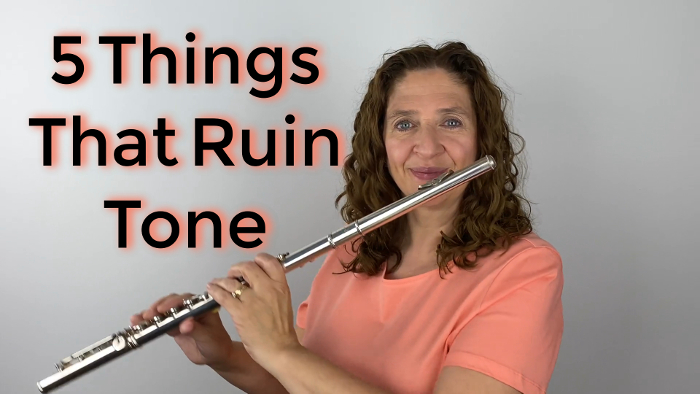Do you want a good sound? Who doesn’t! However, it is often difficult to figure out how to get that great sound. There could be things that you are doing right now that inhibit your ability to get a great tone.
In this blog I will teach you 5 things that you could be doing right now that could be preventing you from achieving that great tone. I will explain to you what the problem is and then teach you how to fix that problem.
Problem # 1
Too much pressure with your lip plate to your lip. Think about this and then play and see if this is your problem. Do your press the flute into your lip with a lot of pressure? If someone cannot use one finger to gently pull the flute away from your lip, then you are pressing your flute too tightly to your lip.
When the lip plate is pushed too hard against your lip, your lower lip will cover too much embouchure hole. The tone then goes straight into the flute and keeps the tone covered. Your goal is to let the tone out and not keep it in.
Try loosening up when you play. The issue is usually the left hand first finger is pressing too hard. When you let up, you will be surprised at how much more comfortable it is to play. The tone relaxes as well and can come out.
Your air needs to be split by the strike edge at the right angle for optimal sound. When you cover too much embouchure hole you cannot use that strike edge to split the sound the right way.
Problem # 2
The mouth cavity is too closed. Or more to the point, everything is closed. That means that inside your mouth, your lips, your teeth are too close together. Being tight and small is really ruining your potential.
If you were my student, I would work on learning to open up one step up at a time. Here I’m telling you what to do all at the same time, but I would suggest that you take one of these at a time and work on it.
Here goes:
Open your teeth
Open your lips
Open your mouth cavity
When these areas are closed your tone is small and tight. It is amazing that when you open up your teeth, lips, and mouth you can fix your tone immediately. Your tone opens up and becomes bigger immediately. It is miraculous.
Problem # 3
Being rolled in too far.
During an online lesson, I noticed that my student was rolled in too far. Online lessons are great in today’s environment. But it is a little bit more difficult for me as a teacher to see how much a student is covering the embouchure. It took a little bit more creativity for me to see but, I was able to figure out that she was indeed covering too much of that embouchure hole.
Her problem was that she was playing with her head down. With the head down ¾ ths of the embouchure hole was covered. When she raised her chin, it was amazing how much her tone opened up and sounded so much better.
Another problem that got fixed by lifting her head was intonation. When you cover too much hole you are often flat. When I’m looking at the student straight on, I generally want to see the outer edge of the tone hole. So, if you look in the mirror, you should be able to see the outer edge. If you see too much hole, you have rolled out too far.
Problem #4
You don’t change your embouchure in different octaves. Our embouchure is not set in stone. It can change and it needs to, absolutely needs to change depending on the octave you’re in. When in the low octave, I’m going to use my low embouchure and change when I’m in the higher octaves. My embouchure needs to be flexible. It needs to move.
My jaw should always be in a state of flux. It moves so that I can get the low register. I remember in high school and even in those early years of college, where I would play a piece and I thought halfway through that piece in that I was performing, my low register was gone. I got nothing, but puffs of air. I’m sure something came out, but it wasn’t great. It wasn’t until I really did this embouchure exploration and learned how my embouchure could be flexible that I realized it’s because I was keeping a high embouchure when I needed to change to a low register.
Problem #5
Blowing too much air.
I can’t tell you how many people I have that the answer to their tone problems is they are blowing too much air. Until you learn how to hold your air in, by support, you will not have the sound you want. Air pressure is the key to holding the air in and not let it come out. Learn how to take that breath and hold that air and tighten up those muscles and keep the air locked inside to control the pace of which that air comes out of your embouchure.
Those are just five reasons that ruin your tone, and you can fix them all today. They are not long hard techniques that take a long period of time to fix each one. If you feel like all five of those are a problem for you, work on them one at a time. You will see that you can get control over your tone and start having a fabulous sound.
Have fun!
DoctorFlute
5 Things That You Do That Can Ruin Your Flute Tone – FluteTips 136

